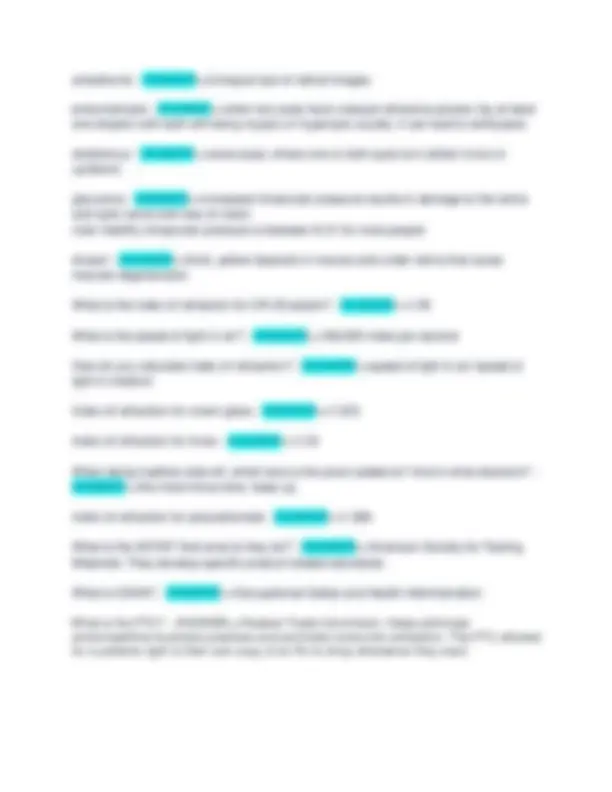





Study with the several resources on Docsity

Earn points by helping other students or get them with a premium plan


Prepare for your exams
Study with the several resources on Docsity

Earn points to download
Earn points by helping other students or get them with a premium plan
Community
Ask the community for help and clear up your study doubts
Discover the best universities in your country according to Docsity users
Free resources
Download our free guides on studying techniques, anxiety management strategies, and thesis advice from Docsity tutors
ABO Exam 2024-2025 With Question And Answer fusion - ANSWER >>the ability of the brain to merge the two images created by the eye optic chasm - ANSWER >>the point at which the optic nerves from the inside half of each eye cross over and then project to the opposite half of the brain fibrous tunic - ANSWER >>sclera and cornea vascular tunic - ANSWER >>choroid, ciliary body, iris neural tunic - ANSWER >>retina palprebral fissure - ANSWER >>the elliptical open space between the eyelids In which direction does the medial rectus turn the eyeball? - ANSWER >>toward the nose In which direction does the lateral rectus turn the eyeball? - ANSWER >>away from the nose In which direction does the superior rectus turn the eyeball? - ANSWER >>upward How much refractive power does the cornea have? - ANSWER >>~ 40 diopters How much refractive power does the crystalline lens have? - ANSWER >>~ 15-16 diopters
Typology: Exams
1 / 7

This page cannot be seen from the preview
Don't miss anything!




fusion - ANSWER>>the ability of the brain to merge the two images created by the eye
optic chasm - ANSWER>>the point at which the optic nerves from the inside half of each eye cross over and then project to the opposite half of the brain
fibrous tunic - ANSWER>>sclera and cornea
vascular tunic - ANSWER>>choroid, ciliary body, iris
neural tunic - ANSWER>>retina
palprebral fissure - ANSWER>>the elliptical open space between the eyelids
In which direction does the medial rectus turn the eyeball? - ANSWER>>toward the nose
In which direction does the lateral rectus turn the eyeball? - ANSWER>>away from the nose
In which direction does the superior rectus turn the eyeball? - ANSWER >>upward
How much refractive power does the cornea have? - ANSWER >>~ 40 diopters
How much refractive power does the crystalline lens have? - ANSWER>>~ 15- 16 diopters
prespyopia - ANSWER>>loss of lens' elasticity and ability to accommodate
What is the fovea and where is it located? - ANSWER>>point in the back of the retina that gives the sharpest vision. it's within the macula and contains only cones.
layers of the cornea - ANSWER>>Epithelium Bowman's membrane Stroma Descemet's membrane Endothelium
vitreous humor - ANSWER>>the transparent jellylike tissue filling the eyeball behind the
lens.
aqueous humor - ANSWER>>fluid in the eye, found between the cornea and the lens
choroid - ANSWER>>blood-rich layer beneath retina that provides nutrients to retina and other parts of the eye
corneal abrasion vs corneal ulcer - ANSWER>>an abrasion is a breakin the surface of epitelium. an ulcer is the loss of it
conjunctiva - ANSWER>>Delicate membrane lining the eyelids and covering the eyeball
Which prism directions cancel each other out? - ANSWER >>base in and base out base up and base up base down and base down
Which prism directions are compounding? - ANSWER>>base up and base down base in and base in base out and base out
How is cancelling prism calculated? - ANSWE R
Subtract the lesser prism value from
the greater one. The lesser prism is cancelled out leaving prism in only one lens in the same direction as that lens' original prism.
subconjuctival hemorrhage - ANSWER>>blood between the conjunctiva and sclera
pinguecula - ANSWER>>yellowish mass on the conjunctiva doesn't usually affect vision
pterygium - ANSWER>>triangular fold of growing membrane that may extend over visual axis and require surgical removal
ptosis - ANSWER>>drooping of upper lid
chalazion - ANSWER>>inflammation of the meibomian or Zeiss gland on eyelid
stye - ANSWER>>(also called hordeolum) acute infection of meibomian or Zeiss gland on lid
antimetropia - ANSWER>>one eye is myopic and the other is hyperopic
What is CPT (Current Procedural Terminology)? - ANSWER>>A worldwide set of medical codes used to indicate and report medical procedures and services to entities like health insurance companies and physicians.
What is EMR (electronic medical records)? - ANSWER>>a digital version of the paper charts in the clinician's office. An EMR contains the medical and treatment history of the patients in one practice.
scotoma - ANSWER>>dark spot in the visual field
esotropia - ANSWER>>consistant inward turned eye
hypophoria - ANSWER>>The tendency for one eye to deviate downward
medial rectus muscle - ANSWER>>Turns the eyes inward towards the nose
inferior rectus muscle - ANSWER>>depresses the eyes (downward movement of the eyes)
inferior oblique muscle - ANSWER>>turns top of eye away from the nose
What is dispersion? - ANSWER>>The separation of visible light into its different colors
pseudophakia - ANSWER>>an eye in which the natural lens is replaced with an artificial lens implant
What's the ABBE value of crown glass? - ANSWER>>
What is the ABBE value of polycarbonate? - ANSWER>>
What is the abbe value of CR-39? - ANSWER>>
What is the ABBE value of Trivex? - ANSWER>>
Tolerance for sphere power in SV and MF lenses - ANSWER>>For 0.00 to (+/-) 6.50 = 0.13 D
For > (+/-) 6.50 = 2%
Tolerance for cylinder power in SV and MF lenses - ANSWER>>0.00 to - 2.00 = 0.13 D
tolerance for horizontal prism - ANSWER>>0.00 to (+/-)2.75 = 0.67 prism diopters
OR
(+/-) 2.75 = 2.5 mm difference from specified PD
tolerance for vertical prism - ANSWER>>0.00 to (+/-) 3.37 = 0.33 prism diopters OR
(+/-) 3.37 = 1 mm difference in height of PRP
minimum blank size equation - ANSWER>>MBS = ED + (2)decentration
visible light wavelength - ANSWER>>400 nm to 750 nm
UV light wavelength - ANSWER>>200 nm to 400 nm
Infrared wavelength - ANSWER>>750 nm - 1000 nm
Cylinder Axis Tolerance >1.50 - ANSWER>>+/- 2°
Cylinder Axis Tolerance >0.25 / less than or equal to 0.50 - ANSWER>>+/- 7°
Cylinder Axis Tolerance >0.12 / less than or equal to 0.25 - ANSWER>>+/- 14°
Vertex Distance formula - ANSWER>>f= diopters/(1-dD)
How much cylinder power is in effect 90 degrees away from the specified axis? - ANSWER>>100%
How much cylinder power is in effect at 45° away from specified axis? - ANSWER>>50% of it
How much cylinder power is in effect at 30° away from specified axis? - ANSWER>>25%
Is retroscopic tilt ever exceptible? If so, when? - ANSWER >>It's not! Ever!
What happens to the effective power of a plus lens when the frame is further from the face? - ANSWER>>The power increases. Only noticible in high power lenses.
prism compensating device - ANSWER>>
lens holder in lensometer - ANSWER>>
angling temple pliers - ANSWER>>
flat/round nylon pliers - ANSWER>>
snipe nose pliers - ANSWER>>fine adjustments of curved areas of pad arms endpieces and eyewires
chassis - ANSWER>>the frame front without temples
guard arms/ pad arms - ANSWER>>small wire arms that hold the nose pad
endpiece - ANSWER>>where frame connects to temples
temple tips - ANSWER>>plastic coverings that cover the ends of the temples over and behind the ears
Vogel's rule - ANSWER>>Rule-of-thumb for predicting base curves: For plus powers: Base = Sphere Power + 6.00 For minus powers: Base = Sphere power / 2 + 6.